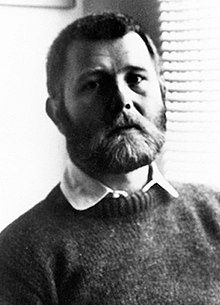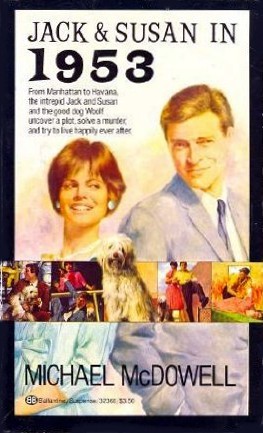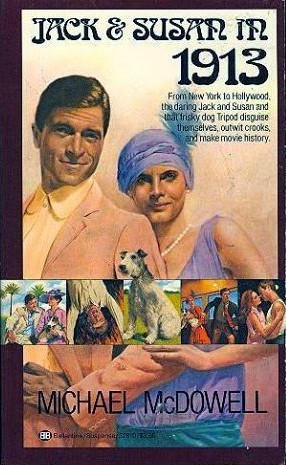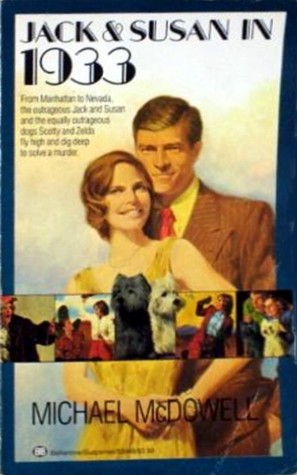The late Michael McDowell, as any true horror fan should know, was one of the genre’s most talented practitioners. Starting with THE AMULET in 1979, the  insanely prolific McDowell turned out several paperback horror novels throughout the eighties, all of consistently high quality: COLD MOON OVER BABYLON, GILDED NEEDLES, THE ELEMENTALS, KATIE, the six-part serial novel BLACKWATER, and TOPLIN.
insanely prolific McDowell turned out several paperback horror novels throughout the eighties, all of consistently high quality: COLD MOON OVER BABYLON, GILDED NEEDLES, THE ELEMENTALS, KATIE, the six-part serial novel BLACKWATER, and TOPLIN.
That’s in addition to a movie novelization (CLUE), several screenplays (BEETLEJUICE, THE DARK HALF, the TALES FROM THE DARKSIDE cable series and feature film) and the many mystery and adventure novels published under various nom de plumes (of his work in the latter category, McDowell declined to publicly disclose his pseudonym because “From the point of view of the publisher and of sales, you wouldn’t want it known that the writer of these books was a member of the National Gay Task Force”).
McDowell’s oddest concoction was the paperback JACK AND SUSAN trilogy, which recounted the adventures of Jack Beaumont and Susan Bright, an attractive young couple (“Eternal yuppies” is how McDowell described them) whose exploits always took place during the third year of each decade. Thus we have JACK AND SUSAN IN 1953 (1985), JACK AND SUSAN IN 1913 (1986) and JACK AND SUSAN IN 1933 (1987). In each, Jack and Susan are both 27 years old, meet for the first time and fall in love amidst richly drawn historical backgrounds. McDowell originally envisioned nine J&S books spanning 1903 to 1983, but only the above three were completed. I don’t know what happened to the remaining six, but can guess that less-than-stellar sales, McDowell’s burgeoning screenwriting career, and his 1999 demise (from “AIDS-related causes”) all had a hand in putting a stop to Jack and Susan’s exploits.
If the J&S novels sound like impenetrable Peter Greenaway-esque experiments, rest assured that they are in fact anything but. Steeped in nostalgia and high-spirited adventure, they’re probably the last thing readers of THE AMULET or GILDED NEEDLES would expect from this defiantly idiosyncratic author (who freely admitted the J&S books were “unlike anything I’ve ever done”). For that matter, if your reading habits are anything like mine, these books are precisely the sort things you’d normally go out of your way to avoid like the clap.
But…before you dismiss the series out of hand, keep in mind that this is Michael McDowell we’re talking about, a novelist with a unique mastery of the form regardless of the genre he was working in–it wasn’t for nothing that Stephen King dubbed him “the finest writer of paperback originals in America.” No, the J&S novels are hardly award-caliber fiction and nor were they intended as such. What they are are page-turning entertainments with convincingly drawn historical milieus, cleverly constructed storylines and a mastery of tone that memorably alternates light-hearted whimsy with gritty action. Quite simply, these books are fun, and if you give them half a chance you may find yourself pleasantly surprised.
JACK AND SUSAN I N 1953 was the first to appear. Why McDowell chose to start with this particular year is beyond me, but he does a fine job sketching the details of life in 1953, when America was still suffering the after effects of WWII, hair oil was all the rage among young men and Cuba was a popular vacation spot. The madcap narrative begins, as it does in the subsequent books, in New York City, where Jack Beaumont is working as a financial planner to a rich woman named Libby. She has a thing for Jack and wants to marry him, but he doesn’t share her affection. Then there’s Susan Bright, who’s going out with the charming but shady Rodolfo. Susan stands to inherit a sizable amount of money and Jack is secretly in love with her. Through a series of plot machinations far too intricate (and plain nutty) to go into here, Jack somehow manages to shake off Libby and marry Susan, while Rodolfo marries Libby(!). It concludes in an action-packed showdown in Cuba, where all the parties happen to be honeymooning(!!). There’s also a mischievous mutt named Woolf, who fills another pivotal role in the J&S books: that of the plucky dog who always accompanies Jack and Susan on their adventures, a different one in each book.
N 1953 was the first to appear. Why McDowell chose to start with this particular year is beyond me, but he does a fine job sketching the details of life in 1953, when America was still suffering the after effects of WWII, hair oil was all the rage among young men and Cuba was a popular vacation spot. The madcap narrative begins, as it does in the subsequent books, in New York City, where Jack Beaumont is working as a financial planner to a rich woman named Libby. She has a thing for Jack and wants to marry him, but he doesn’t share her affection. Then there’s Susan Bright, who’s going out with the charming but shady Rodolfo. Susan stands to inherit a sizable amount of money and Jack is secretly in love with her. Through a series of plot machinations far too intricate (and plain nutty) to go into here, Jack somehow manages to shake off Libby and marry Susan, while Rodolfo marries Libby(!). It concludes in an action-packed showdown in Cuba, where all the parties happen to be honeymooning(!!). There’s also a mischievous mutt named Woolf, who fills another pivotal role in the J&S books: that of the plucky dog who always accompanies Jack and Susan on their adventures, a different one in each book.
For his next J&S book McDowell took a jump back in time to the year 1913 and the early days of the motion picture industry. JACK AND SUSAN IN 1913 is probably the best book of the trilogy, with the most imaginative storyline and most intriguing setting. This time around Susan is an actress and Jack an inventor. In the requisite New York setting Susan finds herself courted by a shadowy fan while constantly running into Jack, who lives below her and always finds ways to call attention to himself. The dog here is a three legged brat named Tripod who follows Susan into the burgeoning “flicker” business, where she finds steady work as a screenwriter and casts Jack in her films, he having attained success by inventing an instrument that holds film in place as it passes through movie cameras. All this changes, however, when Susan learns Jack has been deceiving her all along: it’s he, it turns out, who has been courting her in the guise of the mysterious fan, and who furthermore paid her initial writing salary. You can bet she’s pissed about this, but it all works out in the end, which takes place in the far-off land of Hollywood, CA, during the making of the most monumental of Susan’s pictures.
 JACK AND SUSAN IN 1933 rounded out the series (even if it does fall in the middle chronologically), with Jack and Susan stuck in the tail end of the Great Depression. Both are, as always, impossibly noble, kind-hearted New Yorkers who find themselves married to scumbags. Worse, there’s a suspicious killing and Susan is falsely implicated. It’s up to the love-struck Jack to clear her name, even as his bitchy wife Barbara does her best to tarnish it forever. The climax occurs at a dude ranch, where Jack makes a fateful discovery in the bowels of an abandoned mineshaft. That’s with the help of the obligatory mutt, of course, although there are two dogs here, Scottish Terriers named Scotty and Zelda. Yes, there’s a happy ending, with the bad guys getting their just desserts and Jack and Susan ending up in each others’ arms, Scotty and Zelda in tow.
JACK AND SUSAN IN 1933 rounded out the series (even if it does fall in the middle chronologically), with Jack and Susan stuck in the tail end of the Great Depression. Both are, as always, impossibly noble, kind-hearted New Yorkers who find themselves married to scumbags. Worse, there’s a suspicious killing and Susan is falsely implicated. It’s up to the love-struck Jack to clear her name, even as his bitchy wife Barbara does her best to tarnish it forever. The climax occurs at a dude ranch, where Jack makes a fateful discovery in the bowels of an abandoned mineshaft. That’s with the help of the obligatory mutt, of course, although there are two dogs here, Scottish Terriers named Scotty and Zelda. Yes, there’s a happy ending, with the bad guys getting their just desserts and Jack and Susan ending up in each others’ arms, Scotty and Zelda in tow.
One more thing that must be said about the JACK AND SUSAN novels is Ballantine graced them with striking cover art in which Jack always appears the same, yet Susan invariably looks wildly different. Why? I’ve no idea. It’s one of many unanswered questions surrounding this series. In any event, I recommend tracking down the J&S books (even if they are, sadly, long out of print), being among the most enjoyable creations of a truly unique mind.
Jack and Susan, R.I.P.
